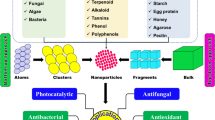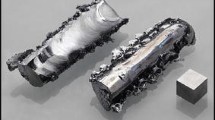Abstract
Purpose. To elucidate the nature of the reactive oxygen species (i.e., superoxide anion radical, hydroxyl radical, and hydrogen peroxide) involved in the metal-catalyzed oxidation of histidine (His) in two model peptides.
Methods. The degradation of AcAla-His-ValNH2 (Ala-peptide) and AcCysNH2-S-S-AcCys-His-ValNH2 (Cys-peptide) was investigated at pH 5.3 and 7.4 in an ascorbate/cupric chloride/oxygen (ascorbate/ Cu(II)/O2) system, both in the absence and presence of selective scavengers (i.e., catalase, superoxide dismutase, mannitol, sodium formate, isopropanol, and thiourea) of the reactive oxygen species. All reactions were monitored by HPLC. The major degradation products were characterized by electrospray mass spectrometry.
Results. The Cys-peptide was more stable than the Ala-peptide at pH 5.3 and 7.4. Both peptides displayed greater stability at pH 5.3 than at 7.4. At pH 5.3, 35 ± 0.7% of the Cys-peptide and 18 ± 1% of the Ala-peptide remained after 7 hours, whereas at pH 7.4, 16 ± 3% of the Cys-peptide and 4 ± 1 % of the Ala-peptide remained. Catalase, thiourea, bicinchoninic acid, and ethylenediaminetetraacetate were effective at stabilizing both peptides toward oxidation, while superoxide dismutase, mannitol, isopropanol, and sodium formate were ineffective. The main degradation products of the Ala- and Cys-peptides at pH 7.4 appeared to be AcAla-2-oxo-His-ValNH2 and AcCysNH2-S-S-AcCys-2-oxo-His-ValNH2, respectively.
Conclusions. Hydrogen peroxide, Cu(I), and superoxide anion radical were deduced to be intermediates involved in the oxidation of the Ala- and Cys-peptides. Hydrogen peroxide degradation to secondary reactive oxygen species may have led to the oxidation of the peptides. The degradation of hydrogen peroxide by a Fenton-type reaction was speculated to form a complexed form of hydroxyl radical that reacts with the peptide before diffusion into the bulk solution.
Similar content being viewed by others
REFERENCES
E. R. Stadtman. Oxidation of free amino acid residues in proteins by metal-catalyzed reactions. Annu. Rev. Biochem. 62:797–821 (1993).
E. R. Stadtman. Metal ion-catalyzed oxidation of proteins: Biochemical mechanism and biological consequences. Free Rad. Biol. Med. 9:315–325 (1990).
E. R. Stadtman. Protein oxidation and aging. Science 257:1220–1224 (1992).
R. S. Sohal and R. Weindruch. Oxidative stress, caloric restriction, and aging. Science 273:59–63 (1996).
E. R. Stadtman and C. N. Oliver. Minireview: Metal-catalyzed oxidation of proteins. Physiological Consequences. J. Biol. Chem. 266:2005–2008 (1991).
K. Uchida and S. Kawakishi. Site-specific oxidation of angiotensin I by copper(II) and L-ascorbate: Conversion of histidine residues to 2-imidazolones. Arch. Biochem. Biophys. 283:20–26 (1990).
K. Uchida and S. Kawakishi. Identification of oxidized histidine generated at the active site of Cu,Zn-superoxide dismutase exposed to H2O2. Selective generation of 2-oxo-histidine at the histidine 118. J. Biol. Chem. 269:2405–2410 (1994).
S. Li, C. Schöneich, and R. T. Borchardt. Chemical instability of protein pharmaceuticals: Mechanisms of oxidation and strategies for stabilization. Biotechnol. and Bioeng. 48:491–500 (1995).
U. Zawitowska, J. Zawitowski, and A.D. Friesen. Applications of immobilized metal affinity chromatography for large-scale purification of endogenous alpha amylase inhibitor from barley kernels. Biotech. Appl. Biochem. 15:160–170 (1992).
E. Hochuli. Large-scale chromatography of recombinant proteins. J. Chromatogr. 444:293–302 (1988).
T. T. Yip, Y. Nakagawa, and J. Porath. Evaluation of the interaction of peptides with Cu(II), Ni(II), and Zn(II) by high performance immobilized metal ion affinity chromatography. Anal. Biochem. 183:159–171 (1989).
M. Below and J. Porath. Immobilized metal ion affinity chromatography, effect of solute structure, ligand density and salt concentration on the retention of peptides. J. Chromatogr. 516:333–354 (1990).
R. Krishnamurthy, R. D. Madurawe, K. D. Bush, and J. A. Lumpkin. Conditions promoting metal-catalyzed oxidations during immobilized Cuiminodiacetic acid metal affinity chromatography. Biotechnol. Prog. 11:643–650 (1995).
S. Li, T. Nguyen, C. Schöneich, and R. T. Borchardt. Aggregation and precipitation of human relaxin induced by metal-catalyzed oxidation. Biochemistry 34:5762–5772 (1995).
T. H. Nguyen, J. Burnier, and W. Meng. The kinetics of relaxin oxidation by hydrogen peroxide. Pharm. Res. 10:1563–1571 (1993).
G. R. Schonbaum and B. Chance. Catalase, The Enzymes, Vol. XIII, Academic Press, New York, 1976.
I. Fridovich. Superoxide dismutases. J. Biol. Chem. 264:7761–7764 (1989).
G. V. Buxton, C. L. Greenstock, W. P. Helman, and A. B. Ross. Critical review of rate constants for reactions of hydrated electrons, hydrogen atoms and hydroxyl radicals in aqueous solution. J. Phys. Chem. Ref. Data 17:513–886 (1988).
M. T. Khan and A. E. Martell. Metal ion and metal chelate catalyzed oxidation of ascorbic acid by molecular oxygen. I. Cupric and ferric ion catalyzed oxidation. J. Am. Chem. Soc. 89:4176–4185 (1966).
Y. Ogata, Y. Kosugi, and T. Morimoto. Kinetics of the cupric salt-catalyzed autooxidation of L-ascorbic acid in aqueous solutions. Tetrahedron 24:4057–4066 (1968).
S. Li, C. Schöneich, G. S. Wilson, and R. T. Borchardt. Chemical pathways of peptide degradation. V. Ascorbic acid promotes rather than inhibits the oxidation of methionine to methionine sulfoxide in small model peptides. Pharm. Res. 10:1572–1579 (1993).
S. J. Lau and B. Sarkar. Kinetic studies of copper(II)-exchange from L-histidine to human serum albumin and diglycyl-L-histidine, a peptide mimicking the copper(II)-transport site of albumin. Can. J. Chem. 53:710–715 (1975).
D. G. Daniele, E. Prenesti, R. Aigotti, and G. Ostacoli. Complex formation between copper(II) and hippuryl-L-histidyl-L-leucine in aqueous solution: A model for coordination properties of internal chains of proteins. J. Inorg. Biochem. 58:139–146 (1995).
H. Kanazawa, S. Fujimoto, and A. Ohara. Site-specific inactivation of papain by ascorbic acid in the presence of cupric ions. Biol. Pharm. Bull. 16:11–18 (1993).
H. Kanazawa, S. Fujimoto, and A. Ohara. Effect of radical scavengers on the inactivation of papain by ascorbic acid in the presence of cupric ions. Biol. Pharm. Bull. 17:476–481 (1994).
D. L. Rabenstein, S. A. Daignault, A. A. Isab, A. P. Arnold, and M. M. Shoukry. Nuclear magnetic resonance studies of the solution chemistry of metal complexes. 21. The complexation of zinc by glycylhistidine and alanylhistidine peptides. J. Am. Chem. Soc. 107:6435–6439 (1985).
L. Casella and M. Gullotti. Coordination modes of histidine. 4. Coordination structures in the copper(II)-L-histidine (1:2) system. J. Inorg. Biochem. 18:19–31 (1983).
R. L. Levine. Oxidative modification of glutamine synthetase. J. Biol. Chem. 258:11828–11833 (1983).
B. G. Ershov, E. Janata, M. Michaelis, and A. Henglein. Reduction of Cu 2+(aq) by CO −2 : First steps and the formation of colloidal copper. J. Phys. Chem. 95:8996–8999 (1991).
J. I. Ueda, Y. Shimazu, and T. Ozawa. Reactions of copper(II)-oligopeptide complexes with hydrogen peroxide: Effects of biological reductants. Free Rad. Biol. Med. 18:929–933 (1995).
E. Shinar, T. Navok, and M. Chevion. The analogous mechanisms of enzymatic inactivation induced by ascorbate and superoxide in the presence of copper. J. Biol. Chem. 258:14778–14783 (1983).
B. Cooper, M. J. Creeth, and A. S. R. Donald. Studies of the limited degradation of mucus glycoproteins. The mechanism of peroxide reaction. Biochem. J. 228:615–626 (1985).
M. J. Creeth, B. Cooper, A. S. R. Donald, and J. R. Clamp. Studies of the limited degradation of mucus glycoproteins. The effect of dilute hydrogen peroxide. Biochem. J. 211:323–332 (1983).
K. Uchida and S. Kawakishi. Reaction of histidyl residue analog with hydrogen peroxide in the presence of copper(II) ion. J. Agric. Food Chem. 38:660–664 (1990).
F. Zhao, J. Yang, and C. Schöneich. Effects of polyaminocarboxylate metal chelators on iron-thiolate induced oxidation of methionine-and histidine-containing peptides. Pharm. Res. 13:931–938 (1996).
F. Zhao, E. Ghezzo-Schöneich, G. I. Aced, J. Hong, T. Milby, and C. Schöneich. Metal-catalyzed oxidation of histidine in human growth hormone. J. Biol. Chem. 272:9019–9029 (1997).
S. A. Lewisch and R. L. Levine. Determination of 2-oxohistidine by amino acid analysis. Anal. Biochem. 231:440–446 (1995).
D. A. Rowley and B. Halliwell. Superoxide-dependent and ascorbate-dependent formation of hydroxyl radicals in the presence of copper salts: A physiologically significant reaction? Arch. Biochem. Biophys. 225:279–284 (1983).
Author information
Authors and Affiliations
Rights and permissions
About this article
Cite this article
Khossravi, M., Borchardt, R.T. Chemical Pathways of Peptide Degradation: IX. Metal-Catalyzed Oxidation of Histidine in Model Peptides. Pharm Res 15, 1096–1102 (1998). https://doi.org/10.1023/A:1011946631197
Issue Date:
DOI: https://doi.org/10.1023/A:1011946631197




